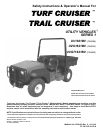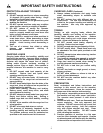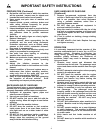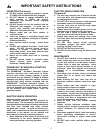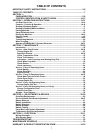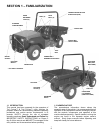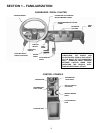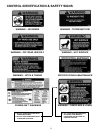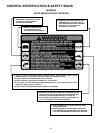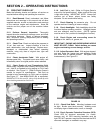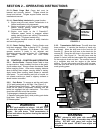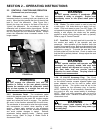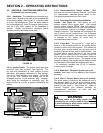
3
IMPORTANT SAFETY INSTRUCTIONS
PROTECTION AGAINST TIPOVERS
(Continued)
8. DO NOT operate machine on slopes exceeding
10 degrees (18% grade) when towing. Cargo
bed must be loaded when towing.
9. DO NOT put your foot on the ground to try and
stabilize the machine.
10. DO NOT operate machine under any condition
where traction, steering or stability is doubtful.
11. DO NOT remove or modify the Operator
Protective Structure. Operator and passenger
must be properly seated and must wear seat
belts, snuggly fastened, at all times.
12. DO NOT shift to neutral and allow machine to
coast down slope. When descending a slope
apply brake to maintain safe speed and drive
straight. Avoid turning when descending a
slope.
13. The use of a helmet, face shield or safety
glasses and substantial clothing is
recommended.
CARRYING LOADS
Carrying loads affects the handling, stability and
braking of the machine. Improper loads, excessive
speed, sharp turns, rough ground, loose or slippery
surfaces and slopes can cause loss of control,
sliding and/or tip-over accidents resulting in
damage, serious injury or death. Extra caution is
required whenever the machine is used to carry
loads.
1. DO NOT exceed rated load capacity of the
machine. Reduce load and speed when
operating machine on slopes.
2. DO NOT carry off-center loads. All loads must
be centered in the cargo bed and secured to
prevent shifting.
3. DO NOT stack loads higher than the sides of the
cargo bed. Keep all loads as low as possible to
minimize effect on stability.
4. Loads affect stability, handling and braking.
Reduce speed, avoid sharp turns, and allow
extra distance for braking.
5. DO NOT attempt to dump loads from cargo bed.
Empty load before raising bed. Raising a
loaded cargo bed can affect stability, resulting
in tip-over.
6. DO NOT drive machine with the cargo bed in a
raised position.
7. DO NOT raise cargo bed when on a slope.
8. Tire pressure is extremely important to the
handling, stability and braking of the machine.
Tire inflation pressure must be maintained as
specified on the machine and in this manual.
CARRYING LOADS
(Continued)
9. Always release accelerator and apply brake
when descending slopes to maintain safe
speed.
10. DO NOT replace tires with different size or
construction. Tire size and construction are
critical to the proper handling and stability of
the machine. Use only tires approved by
manufacturer.
TOWING
Towing, as with carrying loads, affects the
handling, stability and braking of the machine.
Towing loads requires extra caution. Reduce
speeds when towing and avoid slopes whenever
possible. Allow extra distance for braking.
1. DO NOT exceed rated towing capacity of
machine. Reduce load on slopes.
2. DO NOT exceed rated tongue capacity of hitch.
3. DO NOT modify hitch. Towed loads must only
be attached to the hitch point provided on the
machine.
4. DO NOT attempt to tow where steering, traction
or stability is doubtful.
5. Tow loads at a speed slow enough to maintain
control. DO NOT exceed 10 MPH while towing.
6. Cargo bed must be loaded when towing to
provide adequate traction and braking.
7. DO NOT tow a load that you cannot safely
control.
8. DO NOT tow loads on rough ground, or loose,
slippery surfaces.
9. DO NOT allow children or others to ride on a
trailer or towed attachment.
10. DO NOT tow the machine behind any other
machine or vehicle.
PREPARATION
Read, understand and follow instructions and
warnings in this manual and on the machine,
engine and attachments. Know the controls and
the proper use of the machine before starting.
1. Only mature, responsible persons shall operate
the machine and only after proper instruction.
The operator must possess a valid driver’s
license.
2. Handle fuel with care. Fuels are flammable and
vapors explosive. Use only approved fuel
container. DO NOT remove fuel cap or add fuel
with the engine running. Add fuel outdoors
only with engine stopped and cool. Clean
spilled fuel from machine. DO NOT smoke
while refueling the machine.
3. Practice operation of machine in a flat open
area free from obstacles and hazards. Operate
at reduced speed until familiar with the handling
of the machine and operation of all controls.
3



